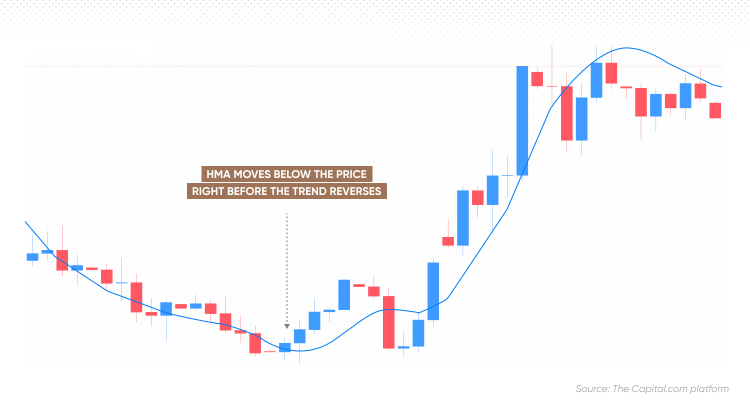What is the Hull Moving Average?
The Hull Moving Average (HMA) is a technical analysis tool that measures the average price of an asset over a period of time. In contrast to traditional moving averages (MA), the indicator aims to minimise the noise and smooth price fluctuations.
Here, we take a look at the indicator’s mechanics and how to design your own Hull Moving Average strategy.
Highlights
HMA is a technical analysis tool that measures the average price of an asset over a period of time, aiming to minimise noise and smooth price fluctuations.
Created by Alan Hull in 2005, HMA has a unique calculation process that combines the benefits of other moving averages like SMA, WMA, and EMA to create a more responsive and smooth indicator.
When using HMA, it’s crucial to select appropriate parameters and timeframes according to your trading style and objectives. Alan Hull recommends a default period of 16.
HMA can be used for identifying trends, spotting trend reversals, determining support and resistance levels, and combining with other indicators for better trading signals.
Popular HMA trading strategies include crossover and breakout.
Hull Moving Average explained
The HMA was created in 2005 by the Australian stock market trader Alan Hull in an attempt to solve the problem of lags in moving averages. As the indicator’s creator put it:
“The Hull Moving Average solves the age-old dilemma of making a moving average more responsive to current price activity whilst maintaining curve smoothness. In fact the HMA almost eliminates lag altogether and manages to improve smoothing at the same time”
The HMA indicator sets itself apart from other moving average types, such as Simple Moving Average (SMA), Weighted Moving Average (WMA), and Exponential Moving Average (EMA), through its unique calculation process that combines the benefits of other moving averages to create a more responsive and smooth indicator.
Hull Moving Average calculation
Although HMA is easily accessed on most charting and trading platforms, understanding the mechanism behind it may be helpful to use it more appropriately. To calculate the HMA on their own, traders can follow these steps:
Choose a number of periods: Suggested by Alan Hull is 16, but traders can use any number suitable for their HMA trading strategy.
Calculate two Weighted Moving Averages (WMAs):
Multiply the shorter-period WMA by two and subtract the first WMA: This result gives you the raw, non-smoothed HMA.
Find the square root of the number of periods: You can round it up or down to the nearest whole number.
Calculate a third WMA using the resulting number: This is your final Hull Moving Average.
In short, the Hull Moving Average formula is:
HMA= WMA(2*WMA(n/2) − WMA(n)),sqrt(n))
Where
WMA = Weighted Moving Average
n = number of periods
sqrt = square root
Hull Moving Average settings for trading
When using the Hull Moving Average, it’s crucial to select the appropriate parameters and timeframes to suit your specific trading style and objectives. The HMA is calculated using a selected period, which determines its responsiveness and smoothness.
Alan Hull, the creator of the HMA indicator, recommends a default period of 16, but traders can experiment to find the best fit for their needs.
To choose the right time frame, consider your trading style and the type of market analysis you wish to perform. For example:
Day trading: Day traders may prefer shorter time frames, such as 1-minute, 5-minute, or 15-minute charts.
Swing trading: Swing traders might opt for 4-hour, daily, or even weekly charts.
Position trading: Position traders may focus on weekly or monthly timeframes to identify longer-term trends.
Remember that selecting the right parameters and timeframes is a trial-and-error process. It’s essential to test various settings using historical price data before applying them to live trading.
How to use the Hull Moving Average in trading
The HMA can be used in various ways, depending on a trader’s strategy. Below are some scenarios where HMA trading can be used.
Identifying trends
The HMA may be particularly useful in trend identification due to its smoothing properties and responsiveness to price changes.
To confirm the trend, you can observe the slope of the HMA line. An upward-sloping HMA signifies a bullish trend, while a downward-sloping HMA points to a bearish trend.
The position of the HMA line in relation to the price is informative too. For example, when the HMA is above price but is upward trending it suggests an uptrend that is likely to face increased resistance. Conversely, when the HMA is below the price but downward trending, it signifies that resistance to the downtrend is likely.










